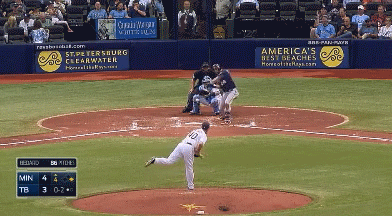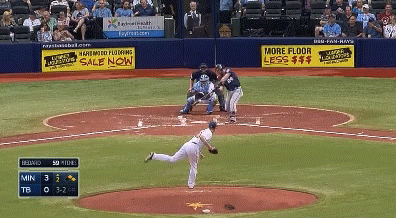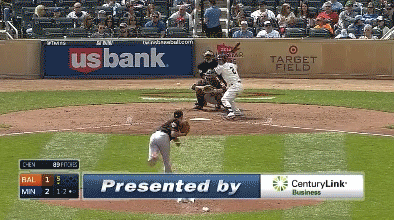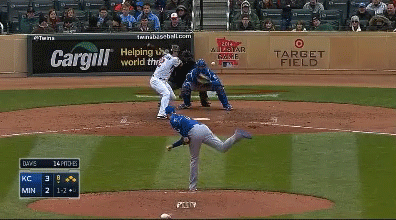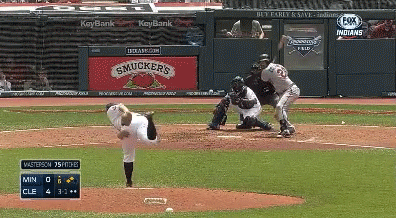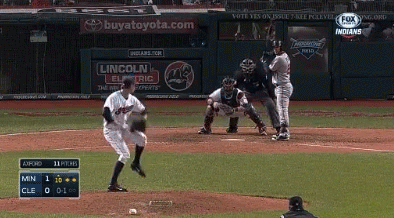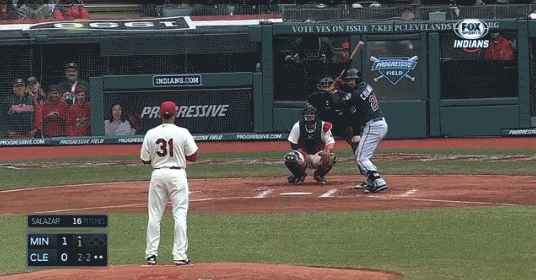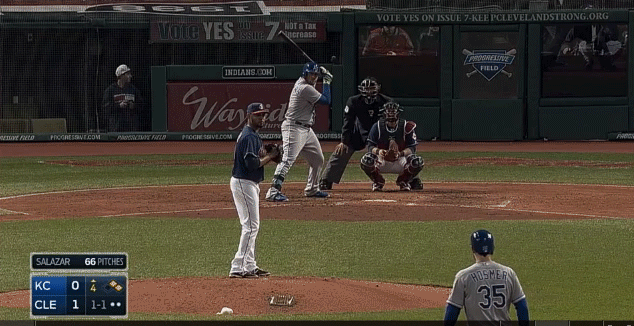Warning: Very long post ahead.
At some point in time, maybe you’ve complained about the lineup your favorite team’s manager used. Maybe you’ve heard of or considered the concept of lineup optimization. Maybe you’ve heard that an optimized lineup, over the course of a full season, wouldn’t make that big of a difference.
It really doesn’t, but that doesn’t make it any less interesting.
In elementary school I spent precious class time attempting to optimize kickball lineups. I suppose that was my first foray into the world of sabermetrics and general baseball nerdiness.
Now, I tend to visit BaseballPress on a daily basis to check the lineups of every team, just because. Even more now, I am writing a long post regarding lineup optimization in the MLB.
Sky Kalkman wrote a great piece on his interpretation of The Book’s findings on lineup optimization. He summed it up with this:
“…we want to know how costly making an out is by each lineup position, based on the base-out situations they most often find themselves in, and then weighted by how often each lineup spot comes to the plate. Here’s how the lineup spots rank in the importance of avoiding outs:
#1, #4, #2, #5, #3, #6, #7, #8, #9
So, you want your best three hitters to hit in the #1, #4, and #2 spots. Distribute them so OBP is higher in the order and SLG is lower. Then place your fourth and fifth best hitters, with the #5 spot usually seeing the better hitter, unless he’s a high-homerun guy. Then place your four remaining hitters in decreasing order of overall hitting ability, with basestealers ahead of singles hitters.”
Following the conclusion of the Major League Baseball regular season, I took to the task of finding each team’s most common starters and lineups, hypothetically optimizing them and comparing the results by which team theoretically cost themselves the most runs by straying from optimization.
I sorted each team’s hitters by plate appearances, made sure there was a representative of every position and used Baseball-Reference’s batting order archive to find the most common order those eight/nine players appeared in to find each team’s hypothetical “most common” lineup.
Then I plugged that lineup into Baseball Musing’s lineup optimization tool, along with their 2013 OBP and SLG to find the optimized lineup for each team.
It’s far from a perfect science, especially with teams like Oakland who often change their lineup by utilizing platoons, but it’s good enough and I wanted an opportunity to tell people much smarter and more qualified than me how to better do their job.
Behold, the results (where rpg is runs per game, season difference is the amount of runs “lost” from a season’s worth of theoretical lineups to optimized lineup, and rank is the most optimized to least optimized lineups):
Boston Red Sox
Common rpg: 5.448. Optimized rpg: 5.547. Season difference: -16.038 runs.
Rank: 10th AL, 24th overall
| 2013 |
OBP |
SLG |
Optimal |
OBP |
SLG |
| CF Ellsbury |
.355 |
.426 |
LF Nava |
.385 |
.445 |
| RF Victorino |
.351 |
.451 |
DH Ortiz |
.395 |
.564 |
| 2B Pedroia |
.372 |
.415 |
RF Victorino |
.351 |
.451 |
| DH Ortiz |
.395 |
.564 |
1B Napoli |
.360 |
.482 |
| 1B Napoli |
.360 |
.482 |
C Saltalamacchia |
.338 |
.466 |
| LF Nava |
.385 |
.445 |
SS Drew |
.333 |
.443 |
| C Saltalamacchia |
.338 |
.466 |
CF Ellsbury |
.355 |
.426 |
| 3B Middlebrooks |
.271 |
.425 |
3B Middlebrooks |
.271 |
.425 |
| SS Drew |
.333 |
.443 |
2B Pedroia |
.372 |
.415 |
Oh, man. Off to a rocky start. Bear with me, folks, they aren’t all this jarring. This is probably the wackiest one that got spit out. The Red Sox obviously would never hit Dustin Pedroia ninth. The Book likes the nine-hitter to be a high OBP, low SLG guy so the top-of-the-order hitters have guys on base when they come to bat. And to be fair, Dustin Pedroia pretty much had the batting profile of a slap-hitter this season. He had the lowest SLG on the team, and his ISO puts his power production below guys like Brandon Crawford and Chris Denorfia. While his great .372 OBP is likely being put to waste in this lineup, Pedroia’s 2013 numbers fit the bill of an optimal #9 hitter when the rest of the lineup is this good.
Tampa Bay Rays
Common rpg: 4.689. Optimized rpg: 4.779. Season difference: -14.580 runs.
Rank: 8th AL, 17th overall
| 2013 |
OBP |
SLG |
Optimal |
OBP |
SLG |
| CF Jennings |
.334 |
.414 |
2B Zobrist |
.354 |
.402 |
| DH Joyce |
.328 |
.419 |
RF Myers |
.354 |
.478 |
| 2B Zobrist |
.354 |
.402 |
DH Joyce |
.328 |
.419 |
| 3B Longoria |
.343 |
.498 |
1B Loney |
.348 |
.430 |
| 1B Loney |
.348 |
.430 |
3B Longoria |
.343 |
.498 |
| RF Myers |
.354 |
.478 |
CF Jennings |
.334 |
.414 |
| LF Johnson |
.305 |
.410 |
SS Escobar |
.332 |
.366 |
| C Molina |
.290 |
.304 |
LF Johnson |
.305 |
.410 |
| SS Escobar |
.332 |
.366 |
C Molina |
.290 |
.304 |
I always like Joe Maddon’s lineups. He mixes things up a lot and isn’t afraid to push the envelope. He’s batted catchers high in the order. He’s led off Ben Zobrist, an excellent – but unconventional – leadoff hitter. For a while this year he batted Evan Longoria second, which is quite smart and probably never would have been considered a decade ago. However, Desmond Jennings isn’t an ideal leadoff hitter with a .330 career OBP and Matt Joyce’s .252 BABIP left him with the lowest OBP of his career. Zobrist is the Rays best leadoff hitter and Wil Myers, arguably the Rays most productive hitter, should be higher in the order.
Baltimore Orioles
Common rpg: 4.724. Optimized rpg: 4.814. Season difference: -14.580 runs.
Rank: 9th AL, 19th overall
| 2013 |
OBP |
SLG |
Optimal |
OBP |
SLG |
| LF McLouth |
.329 |
.399 |
LF McLouth |
.329 |
.399 |
| 3B Machado |
.314 |
.432 |
1B Davis |
.370 |
.634 |
| RF Markakis |
.329 |
.356 |
SS Hardy |
.306 |
.433 |
| CF Jones |
.318 |
.493 |
CF Jones |
.318 |
.493 |
| 1B Davis |
.370 |
.634 |
3B Machado |
.314 |
.432 |
| C Wieters |
.287 |
.417 |
DH Flaherty |
.293 |
.390 |
| SS Hardy |
.306 |
.433 |
2B Roberts |
.312 |
.392 |
| DH Flaherty |
.293 |
.390 |
C Wieters |
.287 |
.417 |
| 2B Roberts |
.312 |
.392 |
RF Markakis |
.329 |
.356 |
Chris Davis started the season out as the Orioles #5 hitter, because no one yet knew he would transform into some sort of robot humanoid. Once the transformation was well underway, Buck Showalter continued batting Davis fifth and a struggling Nick Markakis third, likely because “if it ain’t broke, don’t fix it,” and the idea that moving a hot batter to a different spot in the order could somehow throw him out of his groove. It took the Orioles until the middle of August to move Davis into the three-hole and by then Davis’ low spot in the order relative to his production likely cost them a handful of runs. Given the disparity of his OBP compared to his teammates, he’s even better suited for the two-hole.
New York Yankees
Common rpg: 3.978. Optimized rpg: 4.077. Season difference: -16.038 runs.
Rank: 1th AL, 25th overall
| 2013 |
OBP |
SLG |
Optimal |
OBP |
SLG |
| CF Gardner |
.344 |
.416 |
CF Gardner |
.344 |
.416 |
| RF Suzuki |
.297 |
.342 |
2B Cano |
.383 |
.516 |
| 2B Cano |
.383 |
.516 |
1B Overbay |
.295 |
.393 |
| DH Hafner |
.301 |
.378 |
DH Hafner |
.301 |
.378 |
| LF Wells |
.282 |
.349 |
SS Nunez |
.307 |
.372 |
| 1B Overbay |
.295 |
.393 |
RF Suzuki |
.297 |
.342 |
| SS Nunez |
.307 |
.372 |
3B Nix |
.308 |
.311 |
| 3B Nix |
.308 |
.311 |
LF Wells |
.282 |
.349 |
| C Stewart |
.293 |
.272 |
C Stewart |
.293 |
.272 |
This isn’t the Yankees lineup we’re used to after the last couple months, or really after the last decade. But as Yankees fans well know, it is the lineup we saw for the majority of the season. Sorry you had to see this again, Yankees fans. The Yankees did hit Robinson Cano in his more deserved second-position for a period of time, but it was basically out of necessity as they had no other real hitters to work with. Instead, Ichiro Suzuki spent the majority of the time in the two-hole seemingly on reputation alone, despite being the third-worst candidate for the spot on a team full of Jayson Nix, Eduardo Nunez and Lyle Overbay’s.
Toronto Blue Jays
Common rpg: 4.791. Optimized rpg: 4.914. Season difference: -19.926 runs.
Rank: 14th AL, 29th overall
| 2013 |
OBP |
SLG |
Optimal |
OBP |
SLG |
| SS Reyes |
.353 |
.427 |
SS Reyes |
.353 |
.427 |
| LF Cabrera |
.322 |
.360 |
DH Encarnacion |
.370 |
.534 |
| RF Bautista |
.358 |
.498 |
CF Rasmus |
.338 |
.501 |
| DH Encarnacion |
.370 |
.534 |
RF Bautista |
.358 |
.498 |
| 1B Lind |
.357 |
.497 |
1B Lind |
.357 |
.497 |
| C Arencibia |
.227 |
.365 |
3B Lawrie |
.315 |
.397 |
| CF Rasmus |
.338 |
.501 |
LF Cabrera |
.322 |
.360 |
| 2B Izturis |
.288 |
.310 |
C Arencibia |
.227 |
.365 |
| 3B Lawrie |
.315 |
.397 |
2B Izturis |
.288 |
.310 |
Like the Rays and Yankees, the Blue Jays experimented for a bit this season and batted Jose Bautista #2. Like the Rays and Yankees, this was very smart. Like the Rays and Yankees, they inexplicably stopped their experiment and reverted to a more traditional lineup. Melky Cabrera was not a good hitter this year, yet there he sits in the most important spot of our hypothetical lineup, while the Blue Jays have three great #2 candidates in Edwin Encarnacion, Bautista and even Adam Lind, who was basically “slow Jose Bautista” this season. Burying Colby Rasmus‘ .500 SLG in the seven-hole also didn’t help. And, no, that isn’t a typo. J.P. Arencibia really finished with a .227 OBP this year.
Detroit Tigers
Common rpg: 5.375. Optimized rpg: 5.510. Season difference: -21.870 runs.
Rank: 15th AL, 30th overall
| 2013 |
OBP |
SLG |
Optimal |
OBP |
SLG |
| CF Jackson |
.337 |
.417 |
DH Martinez |
.355 |
.430 |
| RF Hunter |
.334 |
.465 |
3B Cabrera |
.442 |
.636 |
| 3B Cabrera |
.442 |
.636 |
2B Infante |
.345 |
.450 |
| 1B Fielder |
.362 |
.457 |
1B Fielder |
.362 |
.457 |
| DH Martinez |
.355 |
.430 |
SS Peralta |
.358 |
.457 |
| LF Dirks |
.323 |
.363 |
CF Jackson |
.337 |
.417 |
| SS Peralta |
.358 |
.457 |
C Avila |
.317 |
.376 |
| C Avila |
.317 |
.376 |
RF Hunter |
.334 |
.465 |
| 2B Infante |
.345 |
.450 |
LF Dirks |
.323 |
.363 |
OK, this one is actually kind of genius. Although OBP is far more important than speed in regards to a leadoff hitter, speed still kind of matters. You probably don’t want your slowest player batting leadoff, especially if you have a burner in the two or three spot. But the Tigers already have the slowest team in baseball, by far, and Miguel Cabrera is their ideal two-hitter. Since Victor Martinez won’t be holding Miggy up on the basepaths, putting his .355 OBP in front of Miggy is actually really smart, especially considering Miggy hits a first-inning homer like half the time anyway. Austin Jackson’s baserunning ability is better suited towards the bottom of the lineup for singles hitters like Alex Avila, Torii Hunter and Andy Dirks. Because of this wildly unconventional lineup, the Tigers ranked last in the study, and I would really love to see this lineup actually get played out.
Cleveland Indians
Common rpg: 4.456. Optimized rpg: 4.509. Season difference: -8.586 runs.
Rank: 2nd AL, 7th overall
| 2013 |
OBP |
SLG |
Optimal |
OBP |
SLG |
| CF Bourn |
.316 |
.360 |
C Santana |
.377 |
.455 |
| 1B Swisher |
.341 |
.423 |
2B Kipnis |
.366 |
.452 |
| 2B Kipnis |
.366 |
.452 |
LF Brantley |
.332 |
.396 |
| C Santana |
.377 |
.455 |
1B Swisher |
.341 |
.423 |
| LF Brantley |
.332 |
.396 |
SS Cabrera |
.299 |
.402 |
| SS Cabrera |
.299 |
.402 |
DH Reynolds |
.307 |
.373 |
| DH Reynolds |
.307 |
.373 |
RF Stubbs |
.305 |
.360 |
| 3B Aviles |
.282 |
.368 |
3B Aviles |
.282 |
.368 |
| RF Stubbs |
.305 |
.360 |
CF Bourn |
.316 |
.360 |
As an Indians fan who was constantly frustrated by Terry Francona’s lineups, their rank in the study surprised me. However, the Indians problem was more with player selection, not lineup order, which isn’t reflected in the study. The Indians best statistical hitter, Ryan Raburn, amassed only 277 PA’s and didn’t make the cut. Yan Gomes, the Indians second best hitter, eventually began receiving his well-deserved playing time, but still finished with just 322 PA’s and missed the cut. To start the season, the Indians buried Carlos Santana‘s great OBP in the six-hole and wouldn’t move Asdrubal Cabrera’s putrid OBP out of the top of the order. But Francona fixed his mistake early enough for it not to be reflected in the years end most common lineup. And in that lineup, the Indians did a good job by having their top five hitters be their highest OBP guys. Michael Bourn was not the leadoff hitter the Indians thought they were signing, and was actually a pretty bad one with a .316 OBP. Santana and Jason Kipnis are much more deserving choices to lead off, though in real life I would likely flip-flop them, considering speed.
Kansas City Royals
Common rpg: 4.094. Optimized rpg: 4.204. Season difference: -17.820 runs.
Rank: 13th AL, 27th overall
| 2013 |
OBP |
SLG |
Optimal |
OBP |
SLG |
| LF Gordon |
.327 |
.422 |
DH Butler |
.374 |
.412 |
| 1B Hosmer |
.353 |
.448 |
1B Hosmer |
.353 |
.448 |
| DH Butler |
.374 |
.412 |
LF Gordon |
.327 |
.422 |
| C Perez |
.323 |
.433 |
C Perez |
.323 |
.433 |
| CF Cain |
.310 |
.348 |
RF Lough |
.311 |
.413 |
| 3B Moustakas |
.287 |
.364 |
SS Escobar |
.259 |
.300 |
| RF Lough |
.311 |
.413 |
CF Cain |
.310 |
.348 |
| 2B Getz |
.288 |
.273 |
3B Moustakas |
.287 |
.364 |
| SS Escobar |
.259 |
.300 |
2B Getz |
.288 |
.273 |
Despite performing poorly in the study, the Royals two lineups were actually pretty close, and theoretically they could have earned themselves a handful more runs by simply swapping Billy Butler and Alex Gordon’s spots in the lineup. I have always loved Gordon as an unconventional leadoff hitter, but this season he stopped taking walks and getting hits on 35% of his balls in play, leading to a pedestrian .327 OBP after posting marks of .376 and .368 the last two seasons. Butler had a weird year, too, as he started walking all the time and lost all his power, posting a lower isolated slugging percentage than David Lough. But Butler is one of the slowest players in baseball and Eric Hosmer is a pretty good baserunner, especially for a first basemen, so swapping their orders in the optimized lineup might make more sense.
Minnesota Twins
Common rpg: 4.301. Optimized rpg: 4.379. Season difference: -12.636 runs.
Rank: 5th AL, 12th overall
| 2013 |
OBP |
SLG |
Optimal |
OBP |
SLG |
| 2B Dozier |
.312 |
.414 |
LF Willingham |
.342 |
.368 |
| C Mauer |
.404 |
.476 |
C Mauer |
.404 |
.476 |
| LF Willingham |
.342 |
.368 |
DH Doumit |
.314 |
.396 |
| 1B Morneau |
.315 |
.426 |
1B Morneau |
.315 |
.426 |
| DH Doumit |
.314 |
.396 |
2B Dozier |
.312 |
.414 |
| 3B Plouffe |
.309 |
.392 |
3B Plouffe |
.309 |
.392 |
| RF Arcia |
.304 |
.430 |
SS Florimon |
.281 |
.330 |
| CF Thomas |
.290 |
.307 |
RF Arcia |
.304 |
.430 |
| SS Florimon |
.281 |
.330 |
CF Thomas |
.290 |
.307 |
Blame slugging percentage for this one. Joe Mauer should really be the Twins leadoff hitter. But, since slugging percentage is flawed in its attempt to represent power by including singles – something Mauer hits a ton of – Mauer has over 100 points of SLG on Josh Willingham, leading the generator to believe Willingham is a more ideal leadoff hitter despite Mauer’s .404 OBP. We all know that Willingham is more of a power hitter than Mauer, which is why we should always use ISO to measure power, where Willingham edges Mauer .159 to .156 even on a down season. Other than the mistake of batting Brian Dozier leadoff, though, the Twins real-life lineup does a pretty great job, with their OBPs falling in descending order after Dozier. If this lineup generator used ISO instead of SLG like I wish it would, flip-flopping Mauer and Willingham at the top would likely be the optimal order for the Twins.
Chicago White Sox
Common rpg: 3.950. Optimized rpg: 4.030. Season difference: -12.960 runs.
Rank: 6th AL, 14th overall
| 2013 |
OBP |
SLG |
Optimal |
OBP |
SLG |
| CF De Aza |
.323 |
.405 |
CF De Aza |
.323 |
.405 |
| SS Ramirez |
.313 |
.380 |
RF Rios |
.328 |
.421 |
| RF Rios |
.328 |
.421 |
3B Gillaspie |
.305 |
.390 |
| 1B Dunn |
.320 |
.442 |
1B Dunn |
.320 |
.442 |
| DH Konerko |
.313 |
.355 |
LF Viciedo |
.304 |
.426 |
| 3B Gillaspie |
.305 |
.390 |
SS Ramirez |
.313 |
.380 |
| LF Viciedo |
.304 |
.426 |
DH Konerko |
.313 |
.355 |
| 2B Keppinger |
.283 |
.317 |
C Flowers |
.247 |
.355 |
| C Flowers |
.247 |
.355 |
2B Keppinger |
.283 |
.317 |
Alejandro De Aza isn’t a great leadoff hitter with a .323 OBP, but when you have the fourth worst team OBP in baseball, .323 will do. The main problem with the White Sox order is their two-hole, as is the problem with most MLB lineups. Alexei Ramirez’s offensive skill set is basically the exact one that MLB managers are beginning to move away from in the 2-hole, with his .313 OBP, complete disappearance of power and newfound penchant for stealing bases. Contrary to conventional wisdom, good base stealers are better suited for the 6/7 spots in the lineup. Risking outs with your best hitters at the plate, who are more likely to drive you in with extra base hits anyway, is not a good idea. With that aside, the White Sox did well by choosing the correct leadoff hitter and keeping their worst hitters at the bottom of the order.
Oakland Athletics
Common rpg: 4.933. Optimized rpg: 4.989. Season difference: -9.072 runs.
Rank: 3rd AL, 8th overall
| 2013 |
OBP |
SLG |
Optimal |
OBP |
SLG |
| LF Crisp |
.335 |
.444 |
3B Donaldson |
.384 |
.499 |
| SS Lowrie |
.344 |
.446 |
SS Lowrie |
.344 |
.446 |
| CF Cespedes |
.294 |
.442 |
DH Smith |
.329 |
.391 |
| 1B Moss |
.337 |
.522 |
1B Moss |
.337 |
.522 |
| 3B Donaldson |
.384 |
.499 |
C Norris |
.345 |
.409 |
| DH Smith |
.329 |
.391 |
CF Cespedes |
.294 |
.442 |
| RF Reddick |
.307 |
.379 |
LF Crisp |
.335 |
.444 |
| C Norris |
.345 |
.409 |
RF Reddick |
.307 |
.379 |
| 2B Sogard |
.322 |
.364 |
2B Sogard |
.322 |
.364 |
Surprise! The Oakland Athletics scored well in a SABR-slanted study. And this doesn’t even take into account how well the A’s optimize their lineup on a daily basis by correctly utilizing platoons. But either way, in this theoretical lineup, the A’s do a good job by getting their second and fourth hitters correct. Though breakout player and MVP-candidate Josh Donaldson is better suited to lead off, Coco Crisp was still a good option. And whether incidental or not, Yoenis Cespedes‘ low OBP in the three-hole doesn’t hurt them too much, as OBP isn’t as important in the three-hole as conventional wisdom would tell you. The A’s do well in this study with the lineup provided for them, and do even better in real life by putting the right guys on the field every day.
Texas Rangers
Common rpg: 4.481. Optimized rpg: 4.582. Season difference: -16.362 runs.
Rank: 12th AL, 26th overall
| 2013 |
OBP |
SLG |
Optimal |
OBP |
SLG |
| 2B Kinsler |
.344 |
.413 |
2B Kinsler |
.344 |
.413 |
| SS Andrus |
.328 |
.331 |
3B Beltre |
.371 |
.509 |
| RF Cruz |
.327 |
.506 |
1B Moreland |
.299 |
.437 |
| 3B Beltre |
.371 |
.509 |
RF Cruz |
.327 |
.506 |
| C Pierzynski |
.297 |
.425 |
C Pierzynski |
.297 |
.425 |
| 1B Moreland |
.299 |
.437 |
CF Martin |
.313 |
.385 |
| LF Murphy |
.282 |
.374 |
DH Profar |
.308 |
.336 |
| DH Profar |
.308 |
.336 |
LF Murphy |
.282 |
.374 |
| CF Martin |
.313 |
.385 |
SS Andrus |
.328 |
.331 |
Ian Kinsler is another guy who doesn’t scream “prototypical leadoff hitter,” basically in the sense that he’s not a speed-first centerfielder, but he is a pretty great one and easily the Rangers best option. So you have to give them credit for sticking with him instead of going to the more conventional, “easy” choice of Elvis Andrus or Leonys Martin. However, the Rangers lose a lot of value by keeping the speedy Andrus in the two-hole, a spot he really wasn’t suited for this season with a career-worst .327 OBP. Adrian Beltre is the perfect fit for the Rangers #2 hitter, and Andrus is better suited for the bottom of the order. With Andrus’ basestealing abilities, I think it would be wiser to switch his spot with Jurickson Profar’s in this optimized lineup, giving Andrus the opportunity to attempt steals with the 8th and 9th hitters up, rather than the 1st and 2nd.
Los Angeles Angels of Anaheim
Common rpg: 4.864. Optimized rpg: 4.945. Season difference: -13.122 runs.
Rank: 7th AL, 15th overall
| 2013 |
OBP |
SLG |
Optimal |
OBP |
SLG |
| LF Shuck |
.331 |
.366 |
C Iannetta |
.358 |
.372 |
| CF Trout |
.432 |
.557 |
CF Trout |
.432 |
.557 |
| 1B Pujols |
.330 |
.437 |
RF Hamilton |
.307 |
.432 |
| RF Hamilton |
.307 |
.432 |
1B Pujols |
.330 |
.437 |
| DH Trumbo |
.294 |
.453 |
2B Kendrick |
.335 |
.439 |
| 2B Kendrick |
.335 |
.439 |
SS Aybar |
.301 |
.382 |
| 3B Callaspo |
.324 |
.347 |
LF Shuck |
.331 |
.366 |
| C Iannetta |
.358 |
.372 |
DH Trumbo |
.294 |
.453 |
| SS Aybar |
.301 |
.382 |
3B Callaspo |
.324 |
.347 |
This one is similar to Detroit’s, but unlike Detroit’s, this one probably only works in theory. When Miggy is batting second and the entire team is slower than molasses in an igloo, I think you can get by with a slow-running, high-OBP guy like Victor Martinez leading off. When your #2 hitter is Mike Trout, you’re probably costing yourself extra bases on would-be Trout doubles and triples by having Chris Iannetta on first in front of him, likely having just drawn a leadoff walk. If Iannetta weren’t so slow and Trout weren’t so fast, Iannetta would actually be a pretty great leadoff hitter. Of all players with 350+ PA this season, only Joey Votto posted a higher BB% (18.6) than Iannetta (17.0). The Angels did do the right thing by putting Trout where he belongs in the two-hole, though. A .432 OBP is great for leadoff, but when you hit for more power than Giancarlo Stanton and Adam Dunn, some of those extra base hits go to waste leading off.
Seattle Mariners
Common rpg: 4.382. Optimized rpg: 4.439. Season difference: -9.234 runs.
Rank: 4th AL, 9th overall
| 2013 |
OBP |
SLG |
Optimal |
OBP |
SLG |
| SS Miller |
.318 |
.418 |
3B Seager |
.338 |
.426 |
| 2B Franklin |
.303 |
.382 |
DH Morales |
.336 |
.449 |
| 3B Seager |
.338 |
.426 |
RF Saunders |
.323 |
.397 |
| DH Morales |
.336 |
.449 |
1B Smoak |
.334 |
.412 |
| LF Ibanez |
.306 |
.487 |
LF Ibanez |
.306 |
.487 |
| 1B Smoak |
.334 |
.412 |
2B Franklin |
.303 |
.382 |
| RF Saunders |
.323 |
.397 |
C Zunino |
.290 |
.329 |
| C Zunino |
.290 |
.329 |
SS Miller |
.318 |
.418 |
| CF Ackley |
.319 |
.341 |
CF Ackley |
.319 |
.341 |
The Mariners began the season with Dustin Ackley at second base and Brendan Ryan at shortstop. By the beginning of June, Ackley had hit himself back to AAA and not much later, the Mariners cut ties with Ryan’s offensive deficiencies in favor of rookies Brad Miller and Nick Franklin. Both held their own with the bat from the get-go, earning themselves the top two spots in the Mariners everyday lineup. However, despite holding their own, neither are really top of the order hitters with sub-.320 OBPs and just average power. Better suited for the top spots are the Mariners best player, Kyle Seager and most productive hitter, Kendrys Morales. Still, the Mariners performed well in the study, likely due to the similar profiles of most of their hitters.
Houston Astros
Common rpg: 4.133. Optimized rpg: 4.176. Season difference: -6.966 runs.
Rank: 1st AL, 3rd overall
| 2013 |
OBP |
SLG |
Optimal |
OBP |
SLG |
| LF Grossman |
.332 |
.370 |
LF Grossman |
.332 |
.370 |
| 2B Altuve |
.316 |
.363 |
C Castro |
.350 |
.485 |
| C Castro |
.350 |
.485 |
2B Altuve |
.316 |
.363 |
| 1B Carter |
.320 |
.451 |
1B Carter |
.320 |
.451 |
| DH Pena |
.324 |
.350 |
3B Dominguez |
.286 |
.403 |
| RF Martinez |
.272 |
.378 |
CF Barnes |
.289 |
.346 |
| CF Barnes |
.289 |
.346 |
DH Pena |
.324 |
.350 |
| 3B Dominguez |
.286 |
.403 |
RF Martinez |
.272 |
.378 |
| SS Villar |
.321 |
.319 |
SS Villar |
.321 |
.319 |
The Astros place third in the study basically by default. It’s not hard to identify your best players and construct a near-optimal lineup when you’ve only got two league-average bats. Just put your best hitter, Jason Castro, in the two-hole, bat Chris Carter fourth to drive in runs and lead off your next highest OBP guy, who believe it or not is a one “Robbie Grossman” and the rest basically doesn’t matter because none of them are very good. Robbie Grossman is actually the most deserving leadoff batter on a real team in the Major League of Baseball. #Astros
Coming soon: Part 2, with National League lineups and conclusion.

